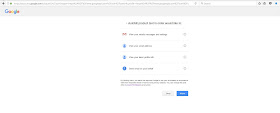1. Obtain OAuth 2.0 credentials from the Google API Console.
First visit to https://console.developers.google.com/ and follow the steps:
Click the "Credentials" as below image:
Now click on "Create credentials" right most part of button and then you can see a dropdown menu as below image:
Now click on "OAuth client ID"
It will show a page like and select "Web application" as below image and provide "Name" and "Authorized redirect URIs" as described and click "Create":
NB: it can say you to create a project, then create a project by click the button.
It will take you to the OAuth client page where you can see "Client ID" & "Client Secret" which would be need later.
You can enable any of your service from google account from list below for specific project:
All google products listed here:
https://developers.google.com/products/
2. Now its time to connect to google via OAuth (Its PHP code snippet):
You have to define your scope first:
$scope = "https://www.googleapis.com/auth/userinfo.profile%20https://www.googleapis.com/auth/userinfo.email%20https://www.googleapis.com/auth/gmail.readonly";
$auth_url = "https://accounts.google.com/o/oauth2/v2/auth";
$client_id = "YOUR CLIENT ID FROM GOOGLE";
$redirect_uri = "http://localhost/tappi/";
$forward_url = $auth_url."?scope=".$scope."&redirect_uri=".urlencode($redirect_uri)."&response_type=code&client_id=".urlencode($client_id);
header("Location: ".$url);
It will redirect you to the following page (if not logged in, login then):
Now click "Allow" button direct you to url you provided when creating application with a code in get parameter
Now you can get access token using the code received.
Full example code below:
<?php
session_start();
init();
if(token() != null) {
echo "<a href='".$_SESSION["redirect_uri"]."'>Home</a>";
echo " || <a href='".$_SESSION["redirect_uri"]."?refresh_token=true'>Refresh token</a>";
echo " || <a href='".$_SESSION["redirect_uri"]."?profile=true'>Profile</a>";
echo " || <a href='".$_SESSION["redirect_uri"]."?logout=true'>Logout</a><br/><br/>\n\n";
}
if(isset($_GET["logout"])) {
flushToken();
echo "Logged out<br/>";
echo "<a href='".$_SESSION["redirect_uri"]."'>Start new session</a>";
die();
}
else if(isset($_GET["refresh_token"])) {
refreshToken();
header("Location: ".$_SESSION["redirect_uri"]);
}
else if(isset($_GET["profile"])) {
viewProfile();
}
else if(token() != null) {
echo "<pre>";print_r(token());echo "</pre>";
}
else if(isset($_GET["code"])) {
$post = "code=".urlencode($_GET["code"])."&client_id=".urlencode($_SESSION["client_id"]);
$post .= "&client_secret=".urlencode($_SESSION["client_secret"]);
$post .="&redirect_uri=".urlencode($_SESSION["redirect_uri"]);
$post .= "&grant_type=authorization_code";
$result = json_decode(runCurl($_SESSION["token_url"], $post));
storeToken($result);
if(isset($result->refresh_token)) {
file_put_contents("rt-".getUserID().".txt", $result->refresh_token);
}
file_put_contents("active.txt", getUserID());
file_put_contents("access_token.txt", $result->access_token);
header("Location: " . $_SESSION["redirect_uri"]);
}
else {
$url = $_SESSION["auth_url"]."?scope=".urlencode($_SESSION["scope"]).
"&redirect_uri=".urlencode($_SESSION["redirect_uri"]).
"&response_type=code&client_id=".urlencode($_SESSION["client_id"])."&access_type=offline";
echo "<a href='".$url."'>Authorize with Google</a>";
}
function refreshToken() {
$post = "client_id=".urlencode($_SESSION["client_id"]);
$post .= "&client_secret=".urlencode($_SESSION["client_secret"]);
$post .= "&redirect_uri=".urlencode($_SESSION["redirect_uri"]);
$post .= "&grant_type=refresh_token&refresh_token=".urlencode(getRefreshToken());
$result = json_decode(runCurl($_SESSION["token_url"], $post));
file_put_contents("access_token.txt", $result->access_token);
storeToken($result);
}
function getRefreshToken() {
$active = file_get_contents("active.txt");
return file_get_contents("rt-".$active.".txt");
}
function flushToken() {
file_put_contents("auth.txt", "");
$_SESSION["redirected"] = null;
}
function token() {
$text = file_exists("auth.txt") ? file_get_contents("auth.txt") : null;
if($text != null && strlen($text) > 0) {
return json_decode($text);
}
return null;
}
function storeToken($o) {
file_put_contents("auth.txt", json_encode($o));
}
function init() {
$_SESSION["auth_url"] = "https://accounts.google.com/o/oauth2/v2/auth";
$_SESSION["token_url"] = "https://accounts.google.com/o/oauth2/token";
$_SESSION["client_id"] = "892386593019-xxxxxxxxxinht701m7kn0gkoj964r2.apps.googleusercontent.com";
$_SESSION["client_secret"] = "bVQ_xT0ZxxxxxxxxxxvV9zRV3";
$_SESSION["redirect_uri"] = "http://localhost/tappi/google.php";
$_SESSION["scope"] = "https://www.googleapis.com/auth/userinfo.profile"; /* User profile */
$_SESSION["scope"] .= " https://www.googleapis.com/auth/userinfo.email"; /* User email address */
$_SESSION["scope"] .= " https://www.googleapis.com/auth/gmail.readonly"; /* Read mail */
$_SESSION["scope"] .= " https://www.googleapis.com/auth/gmail.send"; /* Send email */
}
function getUserID() {
$fromSession = valueFromSession("google_user_id");
if($fromSession) {
return $fromSession;
}
else {
$apiUrl = "https://www.googleapis.com/oauth2/v1/userinfo?alt=json";
$apiUrl .= "&access_token=".token()->access_token;
$result = json_decode(runCurl($apiUrl));
$_SESSION["google_user_id"] = $result->id;
return $_SESSION["google_user_id"];
}
}
function valueFromSession($name) {
if(isset($_SESSION[$name])) {
return $_SESSION[$name];
}
return null;
}
function viewProfile() {
$apiUrl = "https://www.googleapis.com/oauth2/v1/userinfo?alt=json";
$apiUrl .= "&access_token=".token()->access_token;
$result = json_decode(runCurl($apiUrl));
echo "<pre>";
print_r($result);
echo "</pre>";
}
function runCurl($url, $post = null, $headers = null) {
$curl = curl_init();
curl_setopt($curl, CURLOPT_URL, $url);
curl_setopt($curl, CURLOPT_POST, $post == null ? 0 : 1);
if($post != null) {
curl_setopt($curl, CURLOPT_POSTFIELDS, $post);
}
curl_setopt($curl, CURLOPT_HTTPAUTH, CURLAUTH_ANY);
curl_setopt($curl, CURLOPT_RETURNTRANSFER, true);
curl_setopt($curl, CURLOPT_SSL_VERIFYPEER, false);
curl_setopt($curl, CURLOPT_SSLVERSION, 1);
if($headers != null) {
curl_setopt($curl, CURLOPT_HEADER, true);
curl_setopt($curl, CURLOPT_HTTPHEADER, $headers);
}
$response = curl_exec($curl);
$http_code = curl_getinfo($curl, CURLINFO_HTTP_CODE);
curl_close($curl);
if($http_code >= 400) {
echo "Error executing request to Office365 api with error code=$http_code<br/><br/>\n\n";
echo "<pre>"; print_r($response); echo "</pre>";
die();
}
return $response;
}
?>






Wonderful
ReplyDeleteExcellent work
ReplyDelete